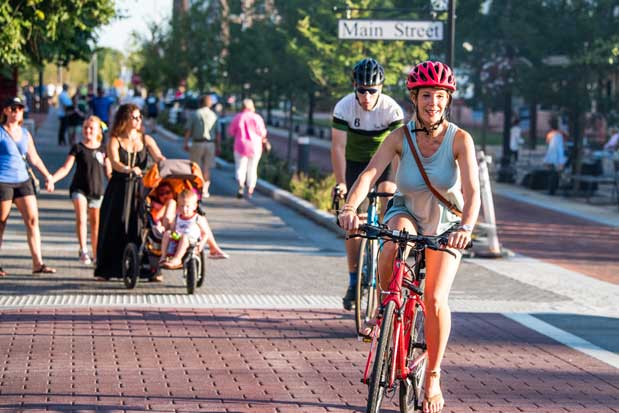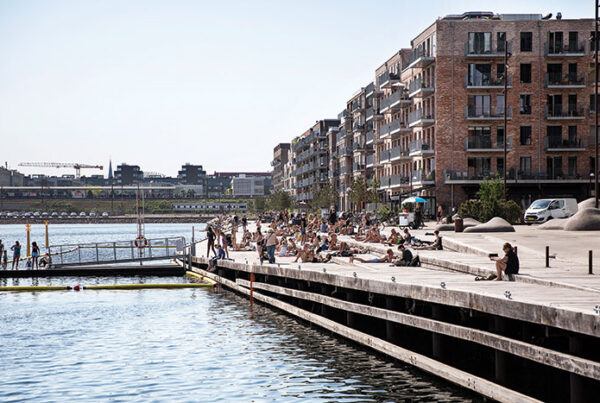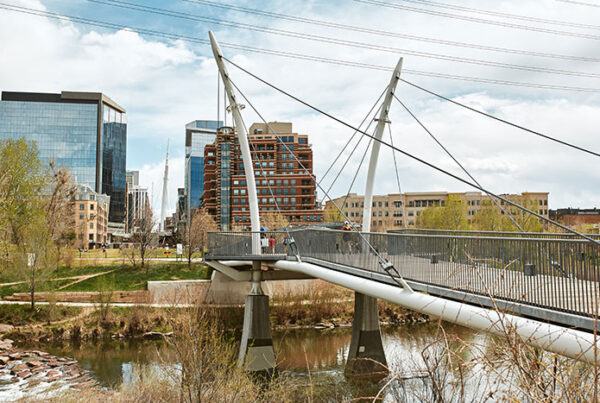Even before the outbreak of COVID-19, equitable access to safe walkways and bike paths had taken on increased importance across the United States. Outdoor spaces for exercise, recreation, and transportation play a role in promoting physical and mental health, in addition to supporting economic development and small enterprise.
A 2020 survey by Rails-to-Trails Conservancy (RTC), a nonprofit organization dedicated to creating a nationwide network of trails, found that nearly half the respondents said access to open spaces had reduced stress levels during the coronavirus pandemic. What’s more, trail use tripled over the summer of 2020 from 2019 levels, RTC reported.
Several metropolitan regions are collaborating to connect trails across cities and towns to form networks that link people to key destinations without having to use a car. Examples include the Circuit Trails, an 800-mile (1,300 km) network of existing and planned trails in and around Philadelphia and southern New Jersey, and burgeoning trail systems in and around the northwest Arkansas and Indianapolis regions.
Cities, developers, advocacy organizations, and other stakeholders are partnering to leverage regional trail connections. But how can cross-sector partners support networks that safely and equitably connect people to places and opportunities to be outdoors?

A set of musical swings by artist Craig Colorusso called “Sound Swings at Uptown,” located at the connection point of the Uptown Fayetteville Apartments internal bike trail to the Mud Creek Trail—part of the area’s growing regional trail network. (Tim Hursley)
How Networks Came to This Crossroad
Trail networks consist of concrete, gravel, or asphalt paths for walkers, runners, people who use wheelchairs or walkers, bladers, skaters, and bicyclists, as well as pet owners. Metropolitan regions are working across sectors to link individual segments to form seamless interconnected networks providing convenient routes to public transit stations, parks, grocery stores, schools, libraries, and other destinations.
The shift of trails from serving as local amenities to becoming part of regional transportation and recreation systems makes urgent the questions of who gets to use trails, what the user experience is, and which stakeholders get to decide where trails should be located.
Dr. Charles T. Brown, leading equity expert, senior researcher, and adjunct professor at Rutgers University’s Alan M. Voorhees Transportation Center, offers some advice for a key trail stakeholder group—real estate developers. Though Brown enjoys walking on regional trails, including those adjacent to new condominiums, food halls, and coffee shops, he warns that developers should not declare success when trails simply boost net property values. Rather, they should approach trail development by seeking to put the welfare of “all people above all things,” he says.
“How does a trail make people feel welcome?” he asks. “Who participates in the design of the trail or the selection of its features?” Measures of success for trails should extend beyond the number of users or the development that occurs nearby. Brown calls on developers to use their leverage to build and manage coalitions, pointing to successful examples, including the Circuit Trails.
One section of the Circuit is the Lawrence-Hopewell Trail (LHT), near Princeton, New Jersey, of which 22 of 26 miles (35 of 42 km) have been built. Originally conceived by employees of Bristol-Myers Squibb in 2001, the LHT connects parks, schools, towns, and corporate campuses—including the Princeton Pike Corporate Center, where real estate developer Brandywine Realty Trust built a segment of trail at its own expense.
The LHT was constructed in sections; the last phase will be constructed when the Trail at Princeton Pike residential community is built, says Tony Ziccardi, vice president of construction and development at Brandywine. This segment will connect to the 70-mile (113 km) Delaware & Raritan Canal State Park.
From the beginning, the LHT has been spearheaded by Becky Taylor and Eleanor Horne, co-presidents of the nonprofit Lawrence Hopewell Trail Corporation board of directors and former executives at large enterprises whose corporate campuses today bookend sections of the trail.
Taylor and Horne speak of the project as one of the most satisfying in their lives, saluting the Mercer County executive and far-sighted corporate leaders and developers who have invested in the trail. Bristol-Myers Squibb, which has a major facility in Lawrenceville, New Jersey, has provided more than $2.5 million for development and construction of the trail, and nonprofit organization ETS, also located along the route, gave additional support, including a cash grant of $250,000 that has helped sustain the trail.
The trail has outlasted suspicions that it would bring crime and impinge on resident tranquility: trail leaders say no one has reported violence or theft on the trail, and real estate agents often advertise the proximity of homes to the trail. Residents of nearby towns who were once skeptical of the trail now frequently ask if new trail segments can be built closer to their homes.
The LHT continues to grow in popularity: use increased 258 percent in 2020 over the previous year, partially due to COVID-19. Yet Horne has reset goals for the trail’s next decade.
“What we did not understand is that one of the chief determinants of a trail being equitable and inclusive is where you place it,” she says.
A major physical barrier is Interstate 95, which separates the LHT from Trenton and many Black, Latin American, and Polish American neighborhoods. My husband and I moved to Trenton three years ago, and I’ve made it a personal goal to connect Trenton to the trail,” Taylor says.

An outdoor gathering space along the Monon Greenway in Carmel, Indiana. (City of Carmel)
Improving Outcomes while Reaching the Destination
The location of trails affects who can reach them, and it follows that those living adjacent to trails are more likely to use them. But even when trails are nearby, steps must be taken to ensure that people feel welcome.
In Arkansas, developer Specialized Real Estate Group worked with infrastructure consultant LaneShift to prioritize locating Bentonville’s Brick Avenue Lofts near bike lanes, paved paths, and trails, including the 36-mile (58 km) Razorback Greenway, which connects to other trails linking Bentonville, Fayetteville, and other destinations in northwest Arkansas. The Greenway cost about $38 million to build, with a mix of funding coming from a federal transportation grant, the Walton Family Foundation, the Northwest Arkansas Regional Planning Commission, and several cities in the region.
Specialized, which prioritizes health in its projects, sees trails as adaptable to and adoptive of the priorities of the diverse rush of new residents from south Asia, Southeast Asia, the Marshall Islands, and Central America who have found employment at area businesses, including the Wal-Mart corporate headquarters in Bentonville.
To boost the power of trails to serve as gathering places, Specialized commissioned a set of sculptural musical swings to invite trail users from the Razorback Greenway into another development—the mixed-use Uptown Fayetteville Apartments, says Sarah King, communications manager for the company. These components work together to provide a healthy, relaxing experience for area residents. The pandemic, which made biking much more popular, will “make trails permanently more integral to a city’s fabric” as well, King says.
When trail and real estate projects are planned in collaboration with local residents, adjacent developments can increase the use of trails, support the quality of life, and create additional chances to experience culture, exercise, and get to know neighbors.
That is happening in Carmel, Indiana, says David Littlejohn, the city’s alternative transportation coordinator. A little more than five miles (8 km) of the regional Monon Greenway—which offers direct connections to trails, including the Central Canal Towpath and Fall Creek Greenway—run through Carmel’s downtown. “We’ve built a really big network so you can get around without owning a car,” Littlejohn says. “Indianapolis to the south and Westfield to the north have seamless connections.”
Kevin Whited, Carmel’s transportation development coordinator, emphasizes the importance of not only connecting trails, but also getting residents to incorporate them into their daily lives—and at an early age, he said, noting that the city is advancing plans to accommodate bike lessons for area youths.
Carmel Mayor James Brainard saw a chance years ago to advance development of the trail and provide a link to Indianapolis along the former Monon Railroad right-of-way. “Carmel’s robust bicycle trail network not only connects the city’s residents and businesses, but also creates connections to [Carmel’s] adjacent communities,” says Brainard. “This network provides bicycle riders safe and direct corridors for recreation as well as transportation.”
Brainard has employed a consistent vision of trails supporting quality of life and sparking development—which is now happening. Three years ago, the town issued a $23 million bond for Monon Boulevard, a project to convert the 12-foot-wide (3.7 m) Monon path into a 140-foot-wide (43 m) corridor with bike lanes, sidewalks, and parks in a formerly slumbering district of warehouses and corn storage facilities.
By 2018, developers had already begun investing $167 million in adjacent projects, including nearly 400,000 square feet (37,000 sq m) of office space, restaurants, retail space, and apartments. Most developments along the Monon Greenway are oriented to take advantage of the trail with features that include indoor bicycle parking, bike maintenance rooms, ramps on stairs, and balconies overlooking the trail.

A multi-use portion of the Monan Parkway in Carmel, Indiana. (City of Carmel)
Moving at the Speed of Trust
Perhaps the most important thing all trail networks have in common is a wide array of committed stakeholders that shape the trails and surrounding areas. Sarah Clark Stuart, executive director of the Bicycle Coalition of Greater Philadelphia and chair of the Circuit Trails, emphasizes the value of aligning goals across groups.
Stuart recalls how representatives from multiple levels of government, neighborhood groups, nonprofit organizations, and others learned to coordinate on grant applications to fund regional trail development. This alignment, she says, helped make the Circuit Trails network real, further expanding awareness of and support for the network among developers and stakeholders.
Patrick Starr, executive vice president of the Pennsylvania Environmental Coalition (PEC) and vice chair of the Circuit Trails, notes that during trail planning and development, routes that pass through existing neighborhoods require the most care. PEC worked to learn from and collaborate with residents who live alongside planned trail connections.
PEC collaborated on the effort to widen sidewalks on a portion of the 58th Street Greenway, a section of the Circuit Trails. But existing neighbors said they should have been asked what their needs were.
“After that, we went out and knocked on the doors of people [who had attended a meeting about plans for the greenway] and talked about what was really on their minds,” Starr recalls. “We learned that they were worried about crime, and we were able to incorporate improved lighting, exercise stations, and an afterschool fix-your-own-bike program.” He and his team learned from that experience to go to where neighbors already held community meetings to identify local priorities and to discuss how they relate to the Circuit Trails.
“Most trail leaders believe they are pursuing justice and that trails are egalitarian since all they require for use is a pair of flip-flops,” says Starr. But different communities need different amenities and come to decisions in different ways.
In retrospect, Starr says the experience was eye-opening. He advises developers, public officials, and volunteers to start their planning with a thorough assessment of who might use the trail and—perhaps even more important—who might consider it an imposition. “It’s especially important to do this in communities that feel the effects of systemic racism,” he says. “But there are a number of systemic ‘isms’ that affect people. Do more work and you’ll get a better result.”
Starr advises trail proponents to move forward at whatever pace the community requires. “One thing people in urban development might get wrong is to say, Hey, we’re on a budget; we only have so much time for staff,” he says. “The project has to move at the speed of trust.”
ALEC APPLEBAUM has written for the New York Times, the Atlantic, and many leading publications on topics including climate change and conservation finance. He is news editor at the Yale Center for Business and Environment and the author of several project profiles on ULI’s Developing Urban Resilience website.




